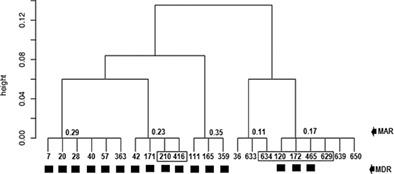当前位置:
X-MOL 学术
›
J. Food Saf.
›
论文详情
Our official English website, www.x-mol.net, welcomes your
feedback! (Note: you will need to create a separate account there.)
Prevalence of Salmonella serotypes S. Enteritidis and S. Typhimurium in poultry and poultry products
Journal of Food Safety ( IF 1.9 ) Pub Date : 2020-08-26 , DOI: 10.1111/jfs.12852 Nagappa Karabasanavar 1 , Chakkodabail Madhavaprasad 1 , Shilpa Gopalakrishna 1 , Jagadish Hiremath 2 , Girish Patil 3 , Sukhadeo Barbuddhe 3
Journal of Food Safety ( IF 1.9 ) Pub Date : 2020-08-26 , DOI: 10.1111/jfs.12852 Nagappa Karabasanavar 1 , Chakkodabail Madhavaprasad 1 , Shilpa Gopalakrishna 1 , Jagadish Hiremath 2 , Girish Patil 3 , Sukhadeo Barbuddhe 3
Affiliation

|
Salmonella continues to be a major food safety and public health threat. In the present study, Salmonella enterica subsp. enterica serotypes Enteritidis (SE) and Typhimurium (ST) were isolated from poultry and characterized for virulence, antimicrobial susceptibility, and biofilm formation. Prevalence of Salmonella serotypes in poultry was 3.35%; predominant serotypes isolated were S. Enteritidis (68.1%) and S. Typhimurium (31.8%). Source‐wise, Salmonella were isolated from retail market chicken meat (4.8%), live chicken at farm (2.5%), and table eggs (2.1%). Salmonella isolates produced invA gene of 284 bp (100%), spvR gene of 310 bp (77.27%), spvC gene of 571 bp (22.72%), and stn gene of 260 bp (100%) as virulence/ pathogenicity determinants. Salmonella isolates exhibited resistance to common antimicrobials; 72.7% isolates showed multiple resistance (≥3 antimicrobial class), highest resistance was observed for polymyxin‐B (81.8%) followed by nalidixic acid (72.7%), colistin (59.1%), ampicillin/tetracyline (45.5%), ampicillin + sulbactam (40.9%), cefodroxil (18.2%), streptomycin (9.1%), and cefazidine/ceftriaxone‐tazobactam (4.5%). Multiple antimicrobial resistance (MAR) index of poultry Salmonella isolates ranged from 0.11 to 0.35; wherein, 59.1% isolates showed MAR of >0.2. About 81.8% Salmonella isolates produced biofilm and were categorized as strong (13.6%), moderate (45.4%), and weak (22.7%) biofilm producers. Occurrence of antimicrobial resistant virulent Salmonella strains in poultry requires implementation of suitable strategies so as to protect the public health.
中文翻译:

家禽和家禽产品中沙门氏菌血清型肠炎沙门氏菌和鼠伤寒沙门氏菌的流行
沙门氏菌仍然是主要的食品安全和公共卫生威胁。在本研究中,沙门氏菌肠亚种。从家禽中分离出肠型血清型肠炎沙门氏菌(SE)和鼠伤寒(ST),并对其毒力,抗菌药敏感性和生物膜形成进行了表征。家禽中沙门氏菌血清型的患病率为3.35%;分离主要血清型为小号。肠炎(68.1%)和小号。鼠伤寒(31.8%)。从源头上讲,沙门氏菌是从零售市场的鸡肉(4.8%),农场的活鸡(2.5%)和食用鸡蛋(2.1%)中分离出来的。沙门氏菌分离株产生了284 bp(100%)的inv A基因,作为毒力/致病性决定因素的310 bp(77.27%)的spv R基因,571 bp(22.72%)的spv C基因和260 bp(100%)的stn基因。沙门氏菌分离株显示出对常见抗菌素的抗性;72.7%的分离物表现出多重耐药性(≥3种抗菌级别),多粘菌素B的耐药率最高(81.8%),其次是萘啶酸(72.7%),粘菌素(59.1%),氨苄青霉素/四环素(45.5%),氨苄西林舒巴坦(40.9%),头孢曲尔(18.2%),链霉素(9.1%)和头孢他啶/头孢曲松-他唑巴坦(4.5%)。家禽沙门氏菌分离株的多重抗药性(MAR)指数范围为0.11至0.35;其中59.1%的分离株的MAR≥0.2。约81.8%沙门氏菌分离株产生了生物膜,被分为强(13.6%),中(45.4%)和弱(22.7%)生物膜生产者。家禽中出现抗药性强的沙门氏菌菌株需要实施适当的策略,以保护公众健康。
更新日期:2020-08-26
中文翻译:

家禽和家禽产品中沙门氏菌血清型肠炎沙门氏菌和鼠伤寒沙门氏菌的流行
沙门氏菌仍然是主要的食品安全和公共卫生威胁。在本研究中,沙门氏菌肠亚种。从家禽中分离出肠型血清型肠炎沙门氏菌(SE)和鼠伤寒(ST),并对其毒力,抗菌药敏感性和生物膜形成进行了表征。家禽中沙门氏菌血清型的患病率为3.35%;分离主要血清型为小号。肠炎(68.1%)和小号。鼠伤寒(31.8%)。从源头上讲,沙门氏菌是从零售市场的鸡肉(4.8%),农场的活鸡(2.5%)和食用鸡蛋(2.1%)中分离出来的。沙门氏菌分离株产生了284 bp(100%)的inv A基因,作为毒力/致病性决定因素的310 bp(77.27%)的spv R基因,571 bp(22.72%)的spv C基因和260 bp(100%)的stn基因。沙门氏菌分离株显示出对常见抗菌素的抗性;72.7%的分离物表现出多重耐药性(≥3种抗菌级别),多粘菌素B的耐药率最高(81.8%),其次是萘啶酸(72.7%),粘菌素(59.1%),氨苄青霉素/四环素(45.5%),氨苄西林舒巴坦(40.9%),头孢曲尔(18.2%),链霉素(9.1%)和头孢他啶/头孢曲松-他唑巴坦(4.5%)。家禽沙门氏菌分离株的多重抗药性(MAR)指数范围为0.11至0.35;其中59.1%的分离株的MAR≥0.2。约81.8%沙门氏菌分离株产生了生物膜,被分为强(13.6%),中(45.4%)和弱(22.7%)生物膜生产者。家禽中出现抗药性强的沙门氏菌菌株需要实施适当的策略,以保护公众健康。









































 京公网安备 11010802027423号
京公网安备 11010802027423号